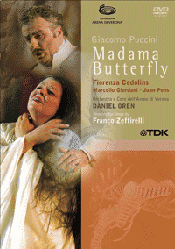Recently
several vintage 1980s' stagings appeared on DVD; your reviewer heartily
recommends a viewing of the Tosca
with Eva Marton, Giacomo Aragall, and Ingvar Wixell. The energetic
scenery-chewing here has a reckless, dentist-be-damned quality, as
every scene is built into a rock face - including Scarpia's office!
Just to see Wixell fly flamboyantly into the chapel, wearing a purple
cape and pumps to match, makes the show a classic.
A Madama Butterfly from July
2004 becomes the latest to appear from this hallowed ground of
over-the-top spectacle. None other than Franco Zeffirelli supplies the
staging, with the innovation of an opening setting in the very busy
streets of Nagasaki, before a rock face splits in two and the future
home of the Pinkerton's slides into view. The pedestrians all seem to
be meeting each other, as they wave delightedly and scramble around.
Goro has the blueprints to the traditional Japanese house (?!?!)
to show Pinkerton before they get around to climbing the hill. In yet
another trademark Zeffirelli touch, quite a few handsome young men
stroll languidly through both the openings of both acts one and two
(this staging takes two intermissions). A younger male makes a
memorable appearance behind the Pinkerton of Marcello Giordani during
his first aria; the tyke not even trying to stifle a huge yawn.
Overall, perhaps a little less busy stage business might have
suited this intimate drama - but it is Verona!
For an ostensibly "traditional" staging, Zeffirelli makes the odd
decision to have Butterfly make her entrance to her future home from
its interior! Yes, she and her attendees appear behind the sliding
doors and advance toward the waiting Pinkerton and Sharpless. Our
Cho-cho-san (as the subtitles spell it, and as actually matches most
romanizations of that sound in Japanese), Fiorenza Cedolins, goes for
the high ending - it is Verona, after all - and holds it for such a
long time that the Verona audience breaks out into wild, noisy
approval. As recorded, the note could have used just a tiny boost
up into the pitch, but it makes an exciting impression anyway.
The sound throughout features a slight echo to the most strenuous
exertions of the singers, and one suspects an amplification system to
deal with the large Verona arena. Even so, none of the singers
(including the Sharpless of Juan Pons) provides much evidence of an
interest in softer singing, with Cedolins in particular becoming quite
wearing on the ears with her mostly unmodulated volume. She also lacks
fragility in her portrayal, though she really convinces in some of
Butterfly's outbursts at Suzuki in act two - the servant might well
have fled for her life at the next assault. Though she has some
impressive moments, ultimately Cedolins's Butterfly is more an assault
on the ears than on the heart.
Giordani makes a tall, attractive Pinkerton, although he appears to
have green highlights in his hair. Is that supposed to make him seem
blond, to explain the golden-haired tyke who appears as his son later?
Or is Zeffirelli suggesting that as a sailor, he has algae growing in
his hair? Only Franco knows. Most importantly, Giordani (who will sing
this role for the opening of the Met's 2007 season) offers some
handsome singing, although he gets a little dry at the end of the love
duet. Pons's stage deportment suggests that Sharpless is more peeved at
being drawn into this drama than anything else, but he is in good voice.
Zeffirelli's most amazing conception occurs during the Humming chorus,
when four ghostly wraiths appear in flowing, dark-colored shifts to
offer an interpretive dance. They then take their place on rock ledges
around Butterfly's house to watch the tragedy unfold. When Butterfly
finally takes out her father's sword, these spectral figures join her
in her fatal collapse. Perhaps the dramatic impact would be greater if
they didn't have what appear to be oversized chicken bones poking
through their messy gray hair. In fact, they seem to have wandered on
stage from a production of Macbeth.
Daniel Oren, not a conductor done any favors by the director's
predilection for close-ups, leads a reading of the score as exuberant,
and as unsubtle, as the production. He even allows a most grating break
in the music before the flower duet. But then again, fighting the
Verona audience's urge to reward loud singing at musical climaxes might
well be a losing battle.
Does the review sound negative? It shouldn't necessarily - if one knows
the Verona style, this DVD makes for a most entertaining diversion.
Puccini's masterpiece is indestructible, it seems - and this DVD, if
nothing else, offers ample proof of that.
Chris Mullins
Los Angeles Unified School District, Secondary Literacy
